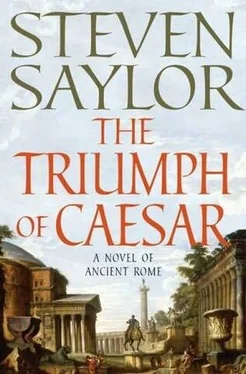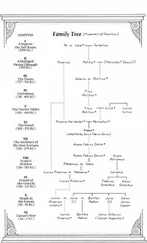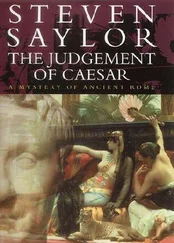Steven Saylor - The Triumph Of Caesar
Здесь есть возможность читать онлайн «Steven Saylor - The Triumph Of Caesar» весь текст электронной книги совершенно бесплатно (целиком полную версию без сокращений). В некоторых случаях можно слушать аудио, скачать через торрент в формате fb2 и присутствует краткое содержание. Жанр: Исторический детектив, на английском языке. Описание произведения, (предисловие) а так же отзывы посетителей доступны на портале библиотеки ЛибКат.
- Название:The Triumph Of Caesar
- Автор:
- Жанр:
- Год:неизвестен
- ISBN:нет данных
- Рейтинг книги:4.5 / 5. Голосов: 2
-
Избранное:Добавить в избранное
- Отзывы:
-
Ваша оценка:
- 100
- 1
- 2
- 3
- 4
- 5
The Triumph Of Caesar: краткое содержание, описание и аннотация
Предлагаем к чтению аннотацию, описание, краткое содержание или предисловие (зависит от того, что написал сам автор книги «The Triumph Of Caesar»). Если вы не нашли необходимую информацию о книге — напишите в комментариях, мы постараемся отыскать её.
The Triumph Of Caesar — читать онлайн бесплатно полную книгу (весь текст) целиком
Ниже представлен текст книги, разбитый по страницам. Система сохранения места последней прочитанной страницы, позволяет с удобством читать онлайн бесплатно книгу «The Triumph Of Caesar», без необходимости каждый раз заново искать на чём Вы остановились. Поставьте закладку, и сможете в любой момент перейти на страницу, на которой закончили чтение.
Интервал:
Закладка:
It was the right thing to say; Bethesda could not suppress a smile of triumph. And it was true. In her heyday, Bethesda had been much more beautiful than Cleopatra, and when I looked at Bethesda now, did I not still see the girl she had been?
A deafening cheer rang out. The procession had begun.
First came the senators and magistrates. Again I saw Cicero and Brutus strolling side by side, talking to each other and ignoring the crowd, as if nothing of importance was taking place.
The trumpeters followed. Their fanfare had a distinctly Egyptian flourish to it, and charged the air with anticipation. What wonders from the distant Nile would Caesar present to the people of Rome?
The spoils of Gaul had been vast and impressive, but the items from Egypt were of another order of magnificence. They were not booty, strictly speaking, since Caesar had not conquered the country; his role had been to end the civil war between the royal siblings and install one of them on the throne. Many of the items displayed that day were gifts from Queen Cleopatra to demonstrate her gratitude to Caesar and to the people of Rome for taking her side in the war with her siblings.
There was a towering black obelisk etched with hieroglyphs and decorated with gold bosses in the shape of lotus blossoms. There were bronze statues of various gods, including an incarnation of the Nile represented as an old man surrounded by river nymphs, with creatures of the deep entwined in his flowing beard. There was a grand procession of magnificent sphinxes, one after another, carved from granite and marble.
The wagons bearing these massive objects were pulled not by beasts but by exotic-looking slaves from the teeming markets of Alexandria. These slaves came from far-off lands whose very names excited wonder-Nubia, Arabia, Ethiopia-and the sight of their dark, gleaming bodies excited almost as much comment as the treasures they were pulling.
The crowd gasped with amazement at the appearance of the final sphinx. It was being pulled by the longest train of slaves, and at a distance appeared to loom far larger than the other sphinxes. This was a trick of the eye. It was not the sphinx but the slaves who were out of scale; these were the miniature people called Pygmies who were said to dwell in a land of dense forests near the source of the Nile. The incongruity of the sight appealed to the Roman sense of humor and prompted gales of laughter.
A replica of the sarcophagus of Alexander was presented, along with several statues of the conqueror. The founding of Alexandria had been his most enduring accomplishment, and his burial place was one of the principle shrines of the city.
There followed a visual catalog of the municipal achievements of Alexander's successors, the Ptolemies. A remarkably detailed model of Alexandria carved from ivory depicted the walls of the city, the great library and museum, the royal palace and the theater, the broad avenues decorated with ancient monuments, and the jetties embracing the great harbor. (Caesar had very nearly met his death in that harbor, when his ship was sunk in a naval engagement and he was forced to swim ashore).
A towering model of the Pharos lighthouse rolled by, complete with a fiery beacon at the summit. This was followed by a model of the gigantic Temple of Serapis and a statue of the god whom the Greek Ptolemies had established as the chief deity of Egypt; Serapis resembled bearded Zeus, or Jupiter, sitting on a throne and wielding a scepter, but on his head he wore a grain basket for a crown and at his feet crouched a three-headed dog meant to be Cerberus but rendered in a style more akin to the jackal-headed Egyptian god, Anubis.
An exotic bestiary followed, featuring the fabled creatures of the Nile and of regions even more remote. Muzzled crocodiles were paraded, fitted with harnesses attached to leashes held by teams of beastmasters: the creatures were so strong and unpredictable, it seemed to take all the keepers' strength to prevent them from lurching into the crowd. Images were displayed of the hippos potamios, the famous Nile river-horse, and of the rhinokeros, which looks like a leathery, overgrown boar brandishing a single monstrous tusk.
The beast show ended with a genuine crowd-pleaser: a troupe of Pygmies rode by, mounted on the gigantic, flightless birds the Greeks call strouthokamelos, "camel-sparrows," famed for their magnificent feathers and absurdly long necks. They are said to hide their heads in the sand when frightened.
There followed an exhibit celebrating the various crops grown along the Nile, the great granary of the Mediterranean, thanks to its yearly inundation. The pretty Egyptian maidens in pleated linen gowns carrying sheaves of grain were not as exciting as crocodiles on leashes, but they nonetheless garnered the crowd's applause, and cheers rang out for Caesar when a crier announced that a distribution of free grain to the citizenry would follow the triumph.
The tone of the procession grew more martial as placards were exhibited showing incidents of the war. (Caesar had promised to tell the full story in his continuing memoirs, but that volume had not yet been published.) There were scenes of the battles in the harbor of Alexandria, in which the skies were filled with flaming missiles hurled from shipboard ballistae. Other scenes illustrated the long siege of the royal palace by the Egyptians, who attempted for months to penetrate Caesar's defenses or else to cut off his water supply, and failed at every turn. There were several scenes of the final, decisive battle on the banks of the Nile, where young King Ptolemy's royal barge was capsized by fleeing Egyptian soldiers. The king's remains were never found; nonetheless, a number of his personal effects had been retrieved from the Nile, including some of his ceremonial weapons and armor, and these magnificent pieces were displayed as trophies.
Other scenes depicted the deaths of Caesar's chief enemies in Egypt. King Ptolemy's lord chamberlain, the eunuch Pothinus, had been forced by Caesar to drink poison for conspiring against him; the man had died before my eyes, cursing both Cleopatra and her brother. The placard illustrating his death portrayed him with exaggerated breasts and hips, which he had not possessed, and feminine makeup, which he had not worn; Pothinus was reduced to a Roman caricature of a eunuch. The crowd laughed and cheered as they were shown the picture of him writhing in agony at Caesar's feet, the death cup still clutched in his hand.
Another placard showed the death of Achillas, the Egyptian general who had mounted the siege against Caesar; it was Arsinoe who eventually executed him for treachery. Achillas was a name of infamy in Rome, for he had been among the murderers of Pompey, delivering the blow that struck the Great One's head from his shoulders even before he could step ashore in Egypt.
Curiously, there was no placard to illustrate Pompey's demise, or the subsequent presentation of Pompey's head as a gift from King Ptolemy to Caesar. Pompey's defeat at Pharsalus, his desperate flight to Egypt, and his ignominious death were not to figure in any of Caesar's triumphs. Whether for fear of hubris, or in deference to the lingering sentimental attachment many Romans felt for Pompey, Caesar did not seize the occasion to gloat over his rival's desecrated corpse.
Others besides me noticed this omission; and clearly not everyone felt sentimental about the Great One. A man called out, "Where is Pompey's head? Show us the head!"
Some joined in this call, but many others groaned, shushed their neighbors, and booed. A ripple of discord passed through the crowd, sparking restlessness and loosening tongues.
"And while you're at it, show us Cleopatra!" someone yelled.
"Yes, where's Cleopatra? Let's have a look at the little nymph who has Caesar so hot and bothered!"
Читать дальшеИнтервал:
Закладка:
Похожие книги на «The Triumph Of Caesar»
Представляем Вашему вниманию похожие книги на «The Triumph Of Caesar» списком для выбора. Мы отобрали схожую по названию и смыслу литературу в надежде предоставить читателям больше вариантов отыскать новые, интересные, ещё непрочитанные произведения.
Обсуждение, отзывы о книге «The Triumph Of Caesar» и просто собственные мнения читателей. Оставьте ваши комментарии, напишите, что Вы думаете о произведении, его смысле или главных героях. Укажите что конкретно понравилось, а что нет, и почему Вы так считаете.










